2014 NISSAN GT-R light
[x] Cancel search: lightPage 45 of 354
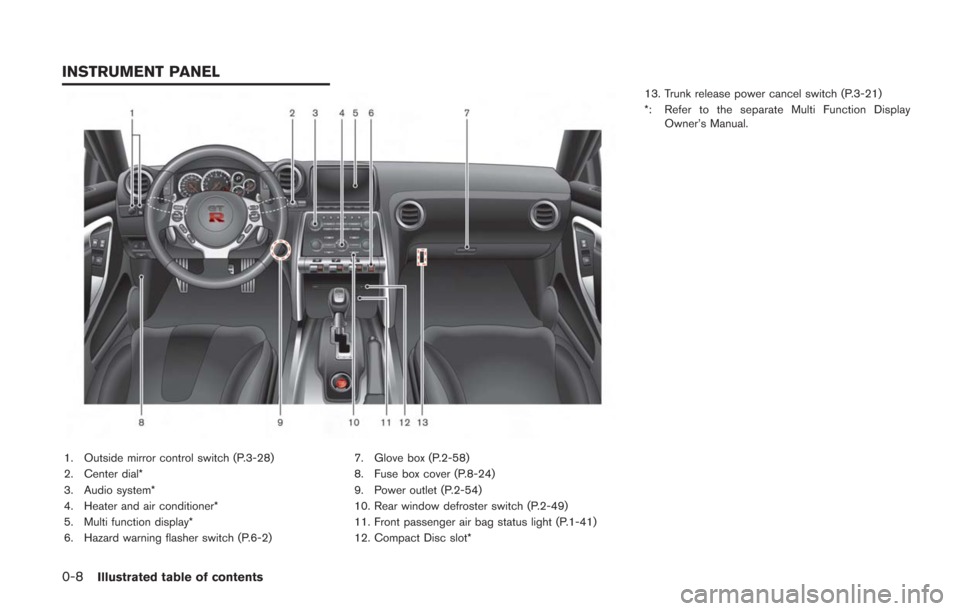
0-8Illustrated table of contents
1. Outside mirror control switch (P.3-28)
2. Center dial*
3. Audio system*
4. Heater and air conditioner*
5. Multi function display*
6. Hazard warning flasher switch (P.6-2)7. Glove box (P.2-58)
8. Fuse box cover (P.8-24)
9. Power outlet (P.2-54)
10. Rear window defroster switch (P.2-49)
11. Front passenger air bag status light (P.1-41)
12. Compact Disc slot*13. Trunk release power cancel switch (P.3-21)
*: Refer to the separate Multi Function Display
Owner’s Manual.
INSTRUMENT PANEL
Page 46 of 354
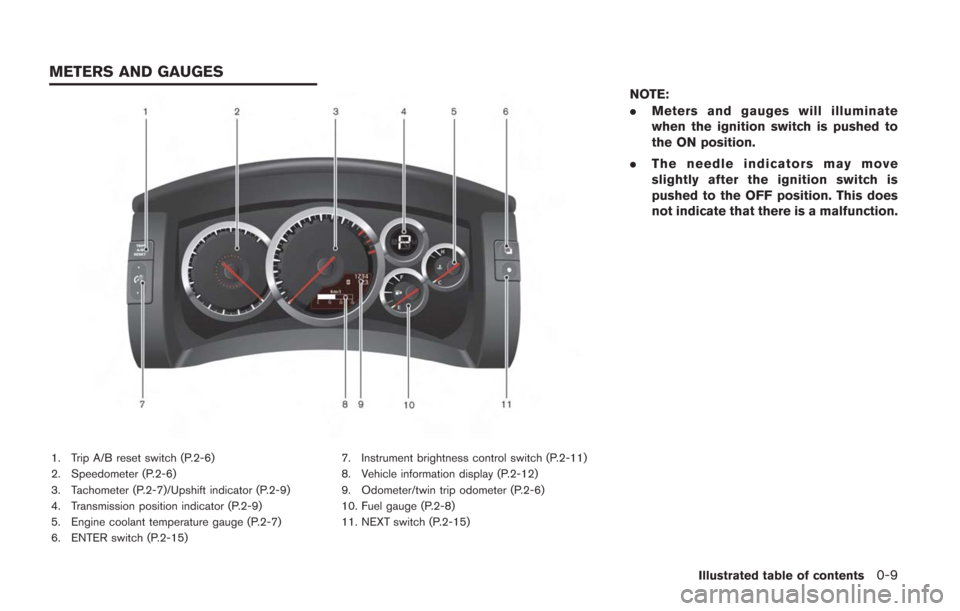
1. Trip A/B reset switch (P.2-6)
2. Speedometer (P.2-6)
3. Tachometer (P.2-7)/Upshift indicator (P.2-9)
4. Transmission position indicator (P.2-9)
5. Engine coolant temperature gauge (P.2-7)
6. ENTER switch (P.2-15)7. Instrument brightness control switch (P.2-11)
8. Vehicle information display (P.2-12)
9. Odometer/twin trip odometer (P.2-6)
10. Fuel gauge (P.2-8)
11. NEXT switch (P.2-15)
NOTE:
.
Meters and gauges will illuminate
when the ignition switch is pushed to
the ON position.
. The needle indicators may move
slightly after the ignition switch is
pushed to the OFF position. This does
not indicate that there is a malfunction.
Illustrated table of contents0-9
METERS AND GAUGES
Page 48 of 354
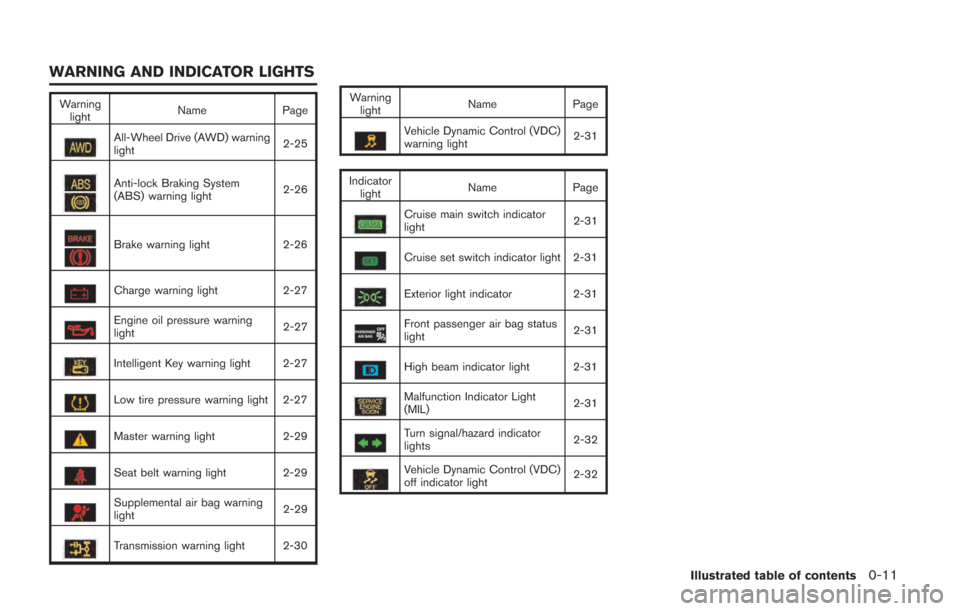
Warninglight Name
Page
All-Wheel Drive (AWD) warning
light 2-25
Anti-lock Braking System
(ABS) warning light2-26
Brake warning light
2-26
Charge warning light2-27
Engine oil pressure warning
light 2-27
Intelligent Key warning light 2-27
Low tire pressure warning light 2-27
Master warning light
2-29
Seat belt warning light 2-29
Supplemental air bag warning
light 2-29
Transmission warning light 2-30 Warning
light Name
Page
Vehicle Dynamic Control (VDC)
warning light 2-31
Indicator light Name
Page
Cruise main switch indicator
light 2-31
Cruise set switch indicator light 2-31
Exterior light indicator
2-31
Front passenger air bag status
light 2-31
High beam indicator light 2-31
Malfunction Indicator Light
(MIL)2-31
Turn signal/hazard indicator
lights
2-32
Vehicle Dynamic Control (VDC)
off indicator light2-32
Illustrated table of contents0-11
WARNING AND INDICATOR LIGHTS
Page 50 of 354
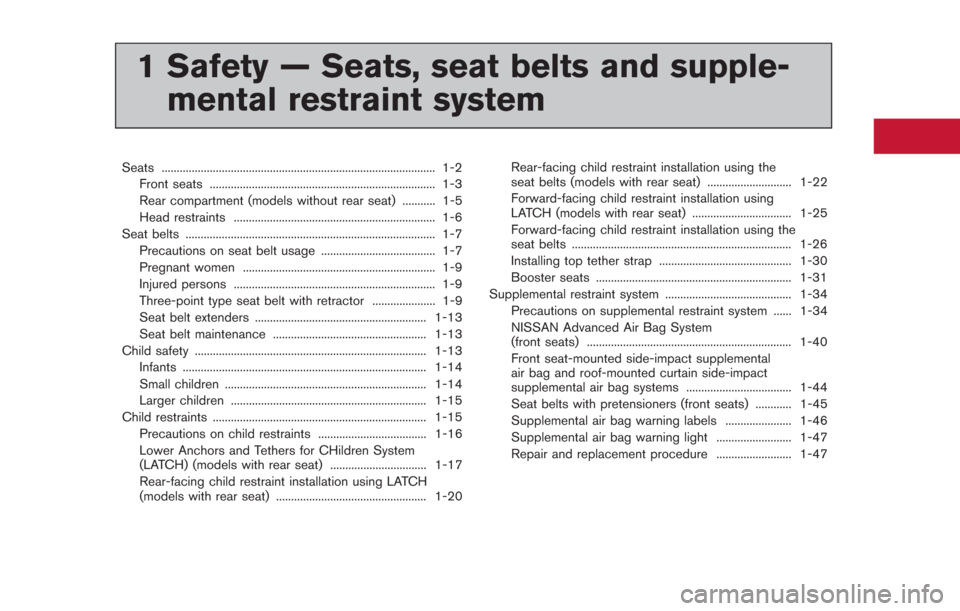
1 Safety — Seats, seat belts and supple-mental restraint system
Seats ........................................................................\
................... 1-2
Front seats ........................................................................\
... 1-3
Rear compartment (models without rear seat) ........... 1-5
Head restraints ................................................................... 1-6
Seat belts ........................................................................\
........... 1-7 Precautions on seat belt usage ...................................... 1-7
Pregnant women ................................................................ 1-9
Injured persons ................................................................... 1-9
Three-point type seat belt with retractor ..................... 1-9
Seat belt extenders ......................................................... 1-13
Seat belt maintenance ................................................... 1-13
Child safety ........................................................................\
..... 1-13 Infants ........................................................................\
......... 1-14
Small children ................................................................... 1-14
Larger children ................................................................. 1-15
Child restraints ....................................................................... 1-15
Precautions on child restraints .................................... 1-16
Lower Anchors and Tethers for CHildren System
(LATCH) (models with rear seat) ................................ 1-17
Rear-facing child restraint installation using LATCH
(models with rear seat) .................................................. 1-20 Rear-facing child restraint installation using the
seat belts (models with rear seat) ............................ 1-22
Forward-facing child restraint installation using
LATCH (models with rear seat) ................................. 1-25
Forward-facing child restraint installation using the
seat belts ........................................................................\
. 1-26
Installing top tether strap ............................................ 1-30
Booster seats ................................................................. 1-31
Supplemental restraint system .......................................... 1-34 Precautions on supplemental restraint system ...... 1-34
NISSAN Advanced Air Bag System
(front seats) .................................................................... 1-40
Front seat-mounted side-impact supplemental
air bag and roof-mounted curtain side-impact
supplemental air bag systems ................................... 1-44
Seat belts with pretensioners (front seats) ............ 1-45
Supplemental air bag warning labels ...................... 1-46
Supplemental air bag warning light ......................... 1-47
Repair and replacement procedure ......................... 1-47
Page 57 of 354
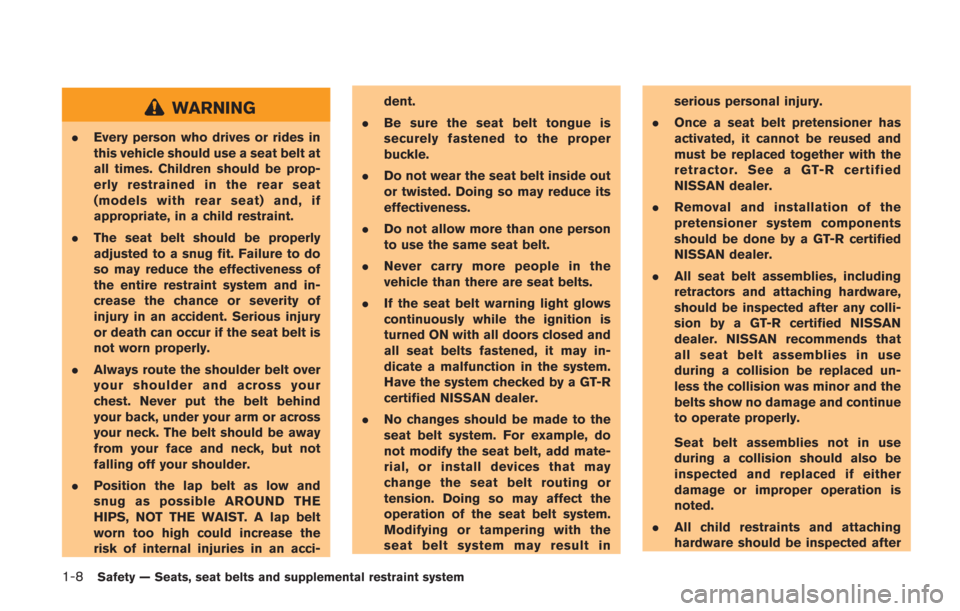
1-8Safety — Seats, seat belts and supplemental restraint system
WARNING
.Every person who drives or rides in
this vehicle should use a seat belt at
all times. Children should be prop-
erly restrained in the rear seat
(models with rear seat) and, if
appropriate, in a child restraint.
. The seat belt should be properly
adjusted to a snug fit. Failure to do
so may reduce the effectiveness of
the entire restraint system and in-
crease the chance or severity of
injury in an accident. Serious injury
or death can occur if the seat belt is
not worn properly.
. Always route the shoulder belt over
your shoulder and across your
chest. Never put the belt behind
your back, under your arm or across
your neck. The belt should be away
from your face and neck, but not
falling off your shoulder.
. Position the lap belt as low and
snug as possible AROUND THE
HIPS, NOT THE WAIST. A lap belt
worn too high could increase the
risk of internal injuries in an acci- dent.
. Be sure the seat belt tongue is
securely fastened to the proper
buckle.
. Do not wear the seat belt inside out
or twisted. Doing so may reduce its
effectiveness.
. Do not allow more than one person
to use the same seat belt.
. Never carry more people in the
vehicle than there are seat belts.
. If the seat belt warning light glows
continuously while the ignition is
turned ON with all doors closed and
all seat belts fastened, it may in-
dicate a malfunction in the system.
Have the system checked by a GT-R
certified NISSAN dealer.
. No changes should be made to the
seat belt system. For example, do
not modify the seat belt, add mate-
rial, or install devices that may
change the seat belt routing or
tension. Doing so may affect the
operation of the seat belt system.
Modifying or tampering with the
seat belt system may result in serious personal injury.
. Once a seat belt pretensioner has
activated, it cannot be reused and
must be replaced together with the
retractor. See a GT-R certified
NISSAN dealer.
. Removal and installation of the
pretensioner system components
should be done by a GT-R certified
NISSAN dealer.
. All seat belt assemblies, including
retractors and attaching hardware,
should be inspected after any colli-
sion by a GT-R certified NISSAN
dealer. NISSAN recommends that
all seat belt assemblies in use
during a collision be replaced un-
less the collision was minor and the
belts show no damage and continue
to operate properly.
Seat belt assemblies not in use
during a collision should also be
inspected and replaced if either
damage or improper operation is
noted.
. All child restraints and attaching
hardware should be inspected after
Page 60 of 354
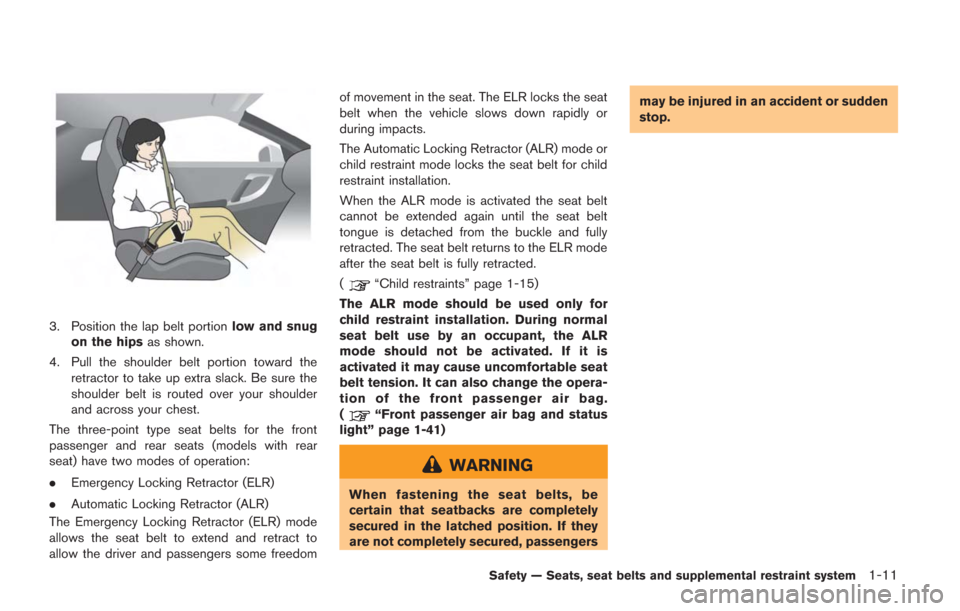
3. Position the lap belt portionlow and snug
on the hips as shown.
4. Pull the shoulder belt portion toward the retractor to take up extra slack. Be sure the
shoulder belt is routed over your shoulder
and across your chest.
The three-point type seat belts for the front
passenger and rear seats (models with rear
seat) have two modes of operation:
. Emergency Locking Retractor (ELR)
. Automatic Locking Retractor (ALR)
The Emergency Locking Retractor (ELR) mode
allows the seat belt to extend and retract to
allow the driver and passengers some freedom of movement in the seat. The ELR locks the seat
belt when the vehicle slows down rapidly or
during impacts.
The Automatic Locking Retractor (ALR) mode or
child restraint mode locks the seat belt for child
restraint installation.
When the ALR mode is activated the seat belt
cannot be extended again until the seat belt
tongue is detached from the buckle and fully
retracted. The seat belt returns to the ELR mode
after the seat belt is fully retracted.
(
“Child restraints” page 1-15)
The ALR mode should be used only for
child restraint installation. During normal
seat belt use by an occupant, the ALR
mode should not be activated. If it is
activated it may cause uncomfortable seat
belt tension. It can also change the opera-
tion of the front passenger air bag.
(
“Front passenger air bag and status
light” page 1-41)
WARNING
When fastening the seat belts, be
certain that seatbacks are completely
secured in the latched position. If they
are not completely secured, passengers may be injured in an accident or sudden
stop.
Safety — Seats, seat belts and supplemental restraint system1-11
Page 71 of 354
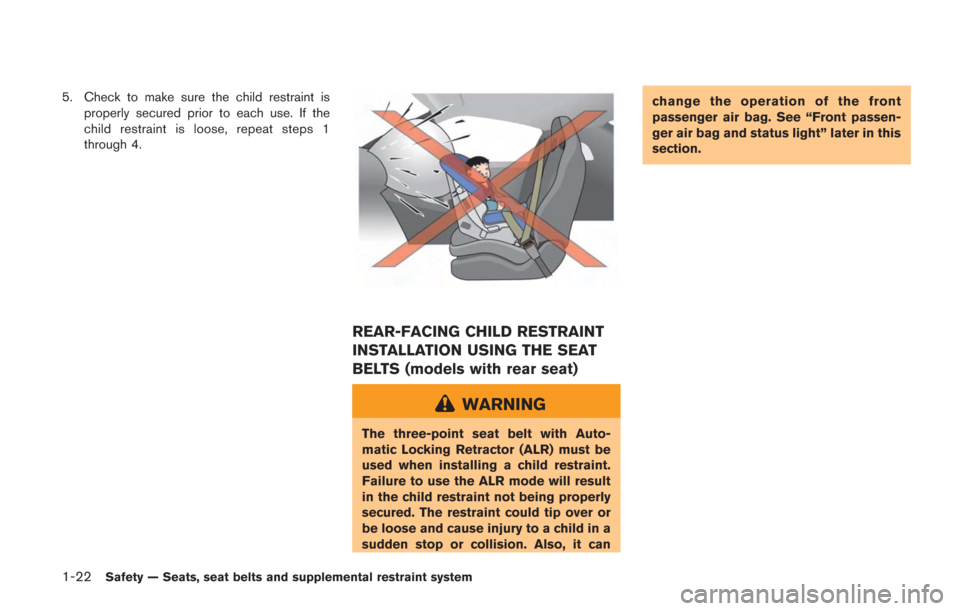
1-22Safety — Seats, seat belts and supplemental restraint system
5. Check to make sure the child restraint isproperly secured prior to each use. If the
child restraint is loose, repeat steps 1
through 4.
REAR-FACING CHILD RESTRAINT
INSTALLATION USING THE SEAT
BELTS (models with rear seat)
WARNING
The three-point seat belt with Auto-
matic Locking Retractor (ALR) must be
used when installing a child restraint.
Failure to use the ALR mode will result
in the child restraint not being properly
secured. The restraint could tip over or
be loose and cause injury to a child in a
sudden stop or collision. Also, it can change the operation of the front
passenger air bag. See “Front passen-
ger air bag and status light” later in this
section.
Page 75 of 354
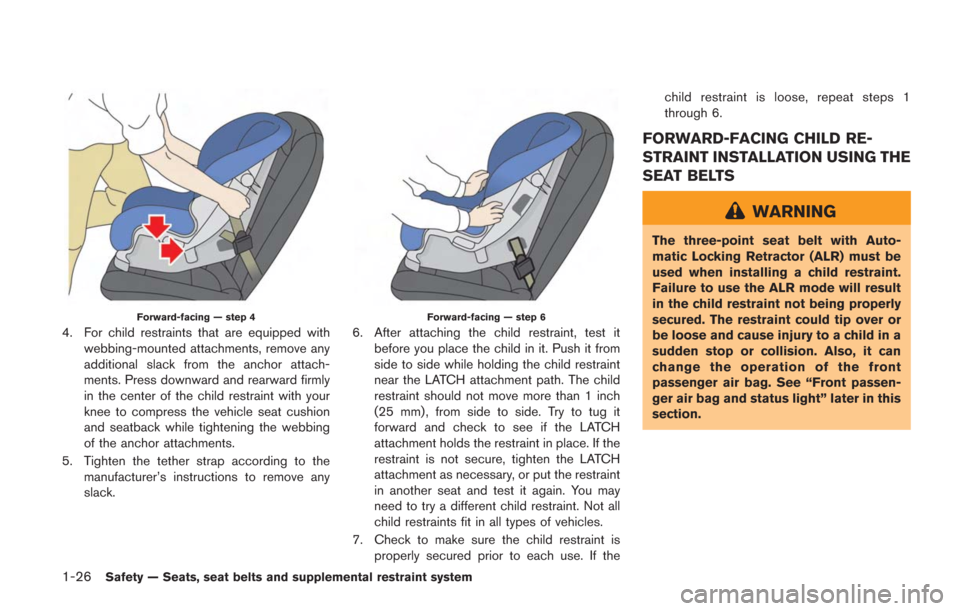
1-26Safety — Seats, seat belts and supplemental restraint system
Forward-facing — step 4
4. For child restraints that are equipped withwebbing-mounted attachments, remove any
additional slack from the anchor attach-
ments. Press downward and rearward firmly
in the center of the child restraint with your
knee to compress the vehicle seat cushion
and seatback while tightening the webbing
of the anchor attachments.
5. Tighten the tether strap according to the manufacturer’s instructions to remove any
slack.
Forward-facing — step 6
6. After attaching the child restraint, test itbefore you place the child in it. Push it from
side to side while holding the child restraint
near the LATCH attachment path. The child
restraint should not move more than 1 inch
(25 mm), from side to side. Try to tug it
forward and check to see if the LATCH
attachment holds the restraint in place. If the
restraint is not secure, tighten the LATCH
attachment as necessary, or put the restraint
in another seat and test it again. You may
need to try a different child restraint. Not all
child restraints fit in all types of vehicles.
7. Check to make sure the child restraint is properly secured prior to each use. If the child restraint is loose, repeat steps 1
through 6.
FORWARD-FACING CHILD RE-
STRAINT INSTALLATION USING THE
SEAT BELTS
WARNING
The three-point seat belt with Auto-
matic Locking Retractor (ALR) must be
used when installing a child restraint.
Failure to use the ALR mode will result
in the child restraint not being properly
secured. The restraint could tip over or
be loose and cause injury to a child in a
sudden stop or collision. Also, it can
change the operation of the front
passenger air bag. See “Front passen-
ger air bag and status light” later in this
section.